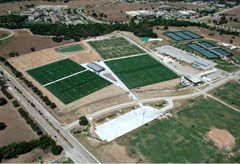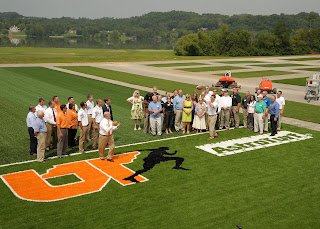
(ROME, Georgia) - The combatants for the 2011 NAIA National Championship football game are set to play on the AstroTurf at Barron Stadium in Rome, Georgia.
Defending champion and six-time national champion Carroll College will take on Saint Xavier University, which is making its first-ever national championship game appearance.
“We’re excited about these two great programs competing for the national championship,” said Bryan Peeples, President of AstroTurf. “The AstroTurf field at Barron Stadium is one of the finest in the country and a major reason the NAIA has chosen to host the championship game in Rome through 2015.”
The Fighting Saints of Carroll College, a Helena, Montana school, are looking to tie Texas A&I for the most national championships in NAIA history. Carroll won four straight titles from 2002-2005, as well as in 2007 and again in last year’s game in Rome.
In the semi-final game, the Saints racked up 447 yards of total offense and converted on nine-of-14 third-down attempts in defeating previously unbeaten Georgetown (Kentucky) 35-3. The Carroll College defense has not given up a second half score in four games.
Saint Xavier, from Chicago, beat top-ranked Marian University 30-27 in the semi-finals. Freshman strong safety Clayton Fejedelem intercepted a pass in the end zone with eight seconds remaining to seal the deal for the Cougars.
The Russell Athletic – NAIA Football National Championship will kick off this Saturday, December 17th, at 4:30 p.m. EST in the 56th installment of the game.
The game will be broadcast in HD by the CBS Sports Network. CBS Sports Network is available across the country through local cable, video, and telecommunications providers. It is also available via satellite on DirecTV Channel 613 and Dish Network Channel 152. For more information, including a full programming schedule and how to get CBS Sports Network, go to www.cbssportsnetwork.com.
The AstroTurf surface at Barron stadium has been credited with keeping the game in Rome after a couple of muddy games on natural grass. Barron Stadium also hosts the high school football games of the Rome Wolves, as well as numerous other events. The heavy usage sometimes made the old natural grass surface susceptible to the weather.
“The new field was really important,” said Bill Peterson, Athletic Director at Shorter University and part of the host committee. “Without the AstroTurf, I doubt that we would have been able to secure a long-term bid. With AstroTurf, the weather becomes irrelevant, even late in the year. ”
In addition, playing the game on the AstroTurf surface generates approximately $2 million per year in economic impact for the community.
The field features the revolutionary new Horseshoe fiber. This new fiber is enjoying unprecedented success in the sports field marketplace, due to factors such as its unique shape. The fiber is an “Omega” shape with two end columns with a thicker diameter. The design imparts mechanical memory so that the fiber remains upright longer, unlike other fields whose fibers quickly flatten and split or shred at the spine. The Horseshoe fiber continues to spring back to its original configuration, even after years of heavy foot traffic or exposure to ultra-violet radiation.
The field has a face weight of 60 ounces of fiber per square yard, the highest in the industry. This adds to the durability provided by the fiber shape.
In extensive testing, the Horseshoe fiber performs most like natural grass from ball roll, to slide
resistance, to the biomechanical function of cleats penetrating and releasing properly. A study at Michigan State University, funded by NFL Charities, found that AstroTurf GameDay Grass systems looked and performed more like natural grass than any other synthetic product measured, also making it the safest option.
The Horseshoe fiber’s shape also allows it to reflect light and heat away from the surface. That, in combination with AstroFlect heat reduction technology, can lower surface temperatures by as much as 18%.
The field features a RootZone, a thatch layer which holds the sand and rubber infill in place for less splash and migration, making for a more consistent playing surface.
The Horseshoe fiber was introduced in 2010 and is already in use on game fields for teams such as Kansas State University; practice fields at schools such as Stanford University, University of Tennessee, and Auburn University; baseball game fields for the Tampa Bay Rays, Wake Forest, Duke, and Ohio State; and numerous high school football fields around the country.
About AstroTurf
For many athletes and sport enthusiasts, the AstroTurf brand has redefined the way the game is played. The company offers advanced, state-of-the-art, multi-sport and specialized synthetic turf systems with proprietary engineered technologies, leveraging the industry’s first vertically integrated manufacturing system. A growing number of high schools, colleges, professional sports teams and municipalities continue to select AstroTurf-branded products for their premium quality, technical superiority and safety. Recent innovations from AstroTurf include GameDay Grass 3D with RootZone, a system which most closely replicates natural grass; a non-chemical antimicrobial shield protecting against MRSA and other infectious bacteria; and AstroFlect technology which significantly reduces turf surface temperatures. To learn more, visit www.astroturfusa.com.






